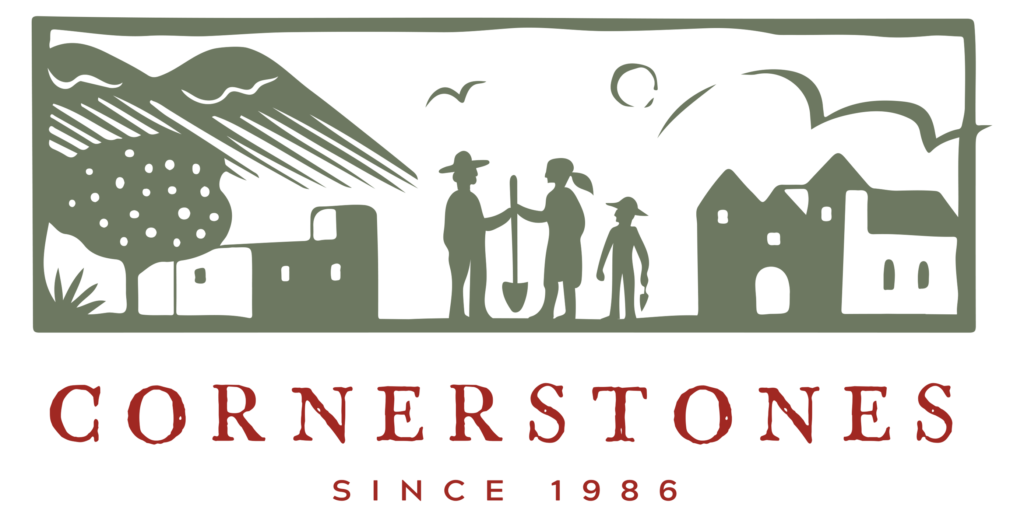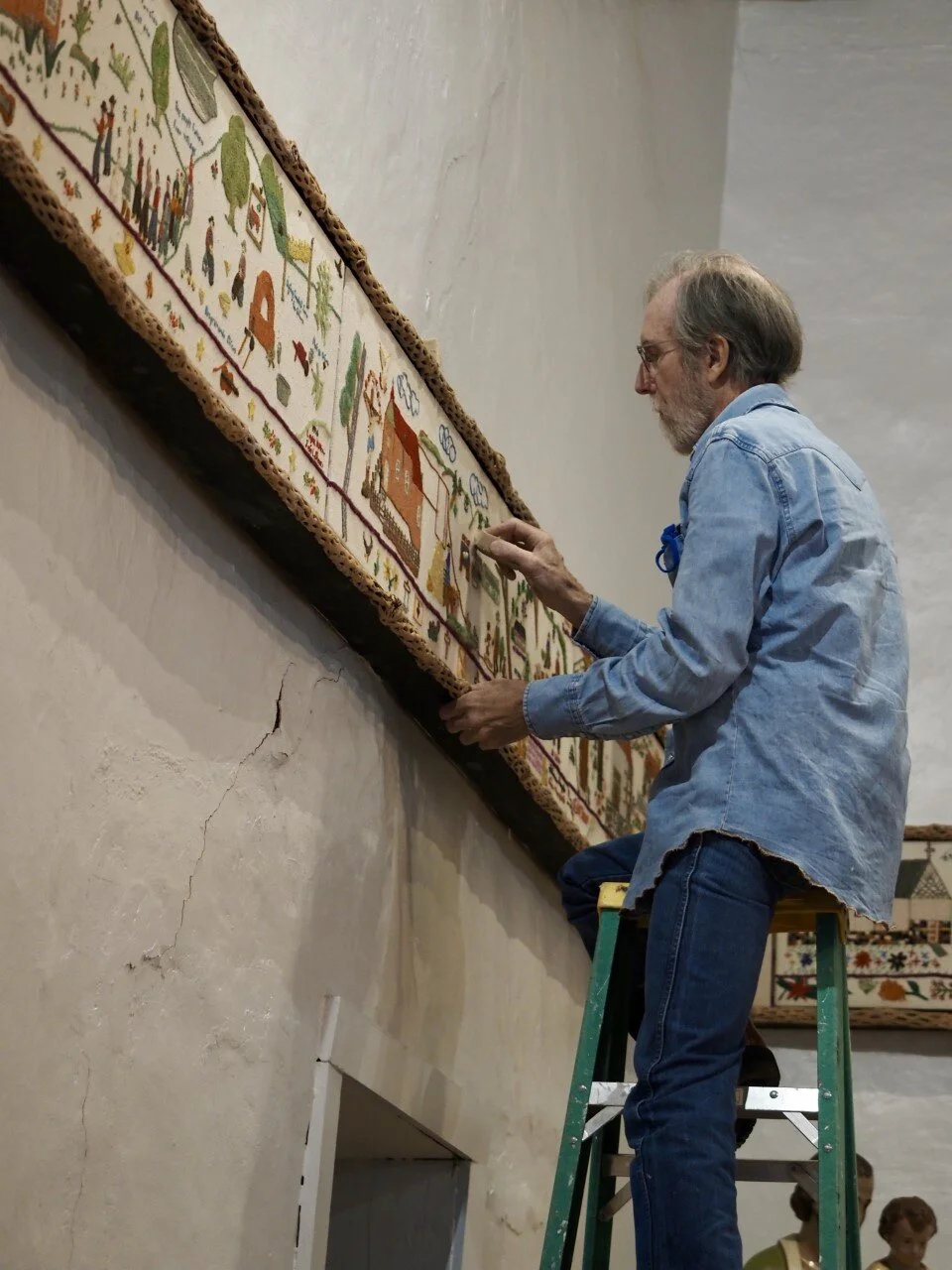STITCHES IN TIME
VILLANUEVA NM WOMEN MAKE HISTORY!
Welcome to Cornerstones Virtual Event for the Villanueva Tapestry.
Jeanne Brako, in rear, the Conservator, and intern Esperanza Sena, clean panels that were stitched by Esperanza’s relatives.
Jack Townes, Conservation Preparator, stands on a tall ladder to clean the Tapestry that is displayed behind the alter.
The cleaning of the Tapestry in Our Lady of Guadalupe Church in Villanueva, New Mexico has been completed.
Miquela Gallegos, a descendent of several of the stitchers, lightly sponges the dirt on a panel along the stairwell that leads to the choir loft.
The Cornerstones’ team wrapped up a concerted two-week effort of delicate cleaning on April 30, 2021. The work alone was challenging. Since its creation in 1976, the work of art had accumulated a layer of soot and soil having survived a long period of wood stove heating as well as a church fire. Preservation was further impacted by strict safety precautions due to COVID-19. But, determination and expertise prevailed.
One of the original stitchers, Sadie Lucero, stopped by to see the progress of the cleaning and decided to join in and clean a bit herself.
The Villanueva project team consisted of Jeanne Brako, Conservator, working with Jack Townes, Conservation Preparator, and Interns, Miquela Gallegos and Esperanza Sena, facilitated by Mellie Gonzales, Our Lady of Guadalupe Business Manager, and Maureen Vosburgh, Cornerstones’ Project Administrator.
The surface cleaning was accomplished by conservation vacuuming through screens and then painstakingly groomed for the entire 265’ length of the Tapestry with soft brushes, special soot removal sponges and other tools of the trade.
As the team was packing up its gear on the last day, the daughter of one of the Stitchers paid an unexpected visit to the church, Her enthusiastic reaction to the refurbishment reenforced the teams’ feeling of jubilation.
Cornerstones became involved with the preservation project in 2019 at the suggestion of Maureen Vosburgh. The initial and most important task was to hire a textile conservator; Jeanne Brako was recommended as the best and was engaged. Research of the Tapestry history was conducted in the archives of The Museum of International Folk Art, which holds the most comprehensive records of the Tapestry project. The Museum was instrumental in securing funds to start the project in 1976.
A proposal for the cleaning process, with budget, was created and presented to Father Moses Nwankwo, Pastor of Our Lady of Guadalupe Church. Upon acceptance of the pro, Father Nwankwo recommended the Tapestry preservation to its owner, The Archdiocese of Santa Fe, who readily agreed. Cornerstones commenced fundraising and the Barbara Erdman Foundation stepped up as the key donor, eventually followed by grants from the Catholic Foundation, Thornburg Investment Management and a generous gift from Phyllis Lehmberg. In order to reach individual donors, invitations to a special fundraising event were mailed, when two days later, COVID-19 curtailed in-person gatherings. It became apparent that the fundraising event was to be virtual. A team was assembled to create a one- hour video telling the story of the Villanueva Tapestry. The video was a series of interviews with remaining Stitchers and some archival, an art historian speaking of the significance of this unique artwork, an explanation of the process by the Conservator and the major funder stating her reason for supporting the project. On January 29, 2021 , The Santa Fe New Mexican featured the Tapestry preservation story on the front page of its morning edition. Cornerstones followed up the article with its one-hour video in the late. The presentation was enthusiastically received with viewers from across the country contributing and sending accolades. The funds, necessary to conduct the preservation work, were in hand and the incredible women who created the Tapestry received due recognition.
Thank you to ALL of the Tapestry donors for supporting this important piece of New Mexico history! We could not have done it without you! Special recognition goes to Barb Odell for her digital photography and film-making expertise, which allowed for state-of-the-art documentation of the Tapestry and the conservation cleaning process.
When COVID leaves us, call Mellie at the church to see for yourself how beautiful and fresh the Tapestry looks.
Photographer: Arthur Taylor Title: Villanueva tapestry project, Villanueva, New Mexico Date: May 20,1976 Negative Number: 077714
Notes: From left to right: Al Kempenich, Budget Director, Museum of New Mexico; Yvonne Lange, Director, Museum of International Folk Art; Rosabel Gallegos, President, Villanueva Art Tapestry Corporation; Helen Thompson, Project Coordinator; Isidora Flores, Vice President, VTC; Toni Sena, Treasurer, VTC; Elisea Garcia, Secretary, VTC; Josie Chavez, Historian, VTC. " The tapestries were inaugurated as a bicentennial project on July 24, 1976 at a mass celebrated by Robert F. Sanchez, Archbishop of Santa Fe, in the presence of Jerry Apodaca, Governor of New Mexico, dignitaries, and the local community.”
Text by Carmen B. de Orrego-Salas
“On July 24, 1976, the tapestry for the Roman Catholic Church of Our Lady of Guadalupe was dedicated in Villanueva, New Mexico. The official presentation of this bicentennial project took place during a mass celebrated by Archbishop Sanchez of Santa Fe, attended by the Governor of New Mexico and other dignitaries, guests and villagers who came to honor the work by 36 local women who for almost two years had labored on 265 ft of embroidery depicting the history of their village. The tapestry has since attracted large numbers of visitors not only interested in textile art but also because it is a vivid comment on a way of life and it constitutes a powerful ethnic document.
Photographer: Betty Lilienthal Title: Villanueva tapestry on exhibit in church,Villanueva, New Mexico Date: July 24, 1976 Negative Number: 109472
Photographer: Betty Lilienthal Title: Villanueva tapestry, Villanueva, New Mexico Date: March 27, 1975 Negative Number: 109462
The project developed at the end of a series of one week workshops I held between 1973 and 1974 in several Spanish villages of Northern New Mexico under the sponsorship of the International Folk Art Foundation of the Museum of New Mexico. Impressed by the potential and cohesive spirit of the group of eleven women attending the workshop I urged them to continue working together and possibly undertaking the execution of a joint project. During our discussion Father Louis Hassenfuss, the parish priest, happened to come into the room and spontaneously suggested the women do a tapestry for the church. The idea appealed to the women as Father Hassenfuss pointed out various incidents pertaining both to the secular and religious history of Villanueva that would be suitable for a church tapestry.
With mounting enthusiasm they went to the church armed with a yardstick, pencil and paper. The women wanted to see where a few panels could be most appropriately placed but soon they exploded in a feverish enumeration of scenes, past and present, combining work, customs and festivities native to their culture that revealed to them the core animating the theme of their project. Suddenly it was no longer a question of a few stitched pieces for their church but a whole sweep of a portrayal of life that could hardly be contained without covering all the available space in the tiny chapel. Thus the tapestry of Villanueva was conceived and today the 265 feet of embroidery runs like a ribbon tying together the nave, the choir, and the sanctuary in a joyful embrace of celebration.
Photographer: Betty Lilienthal Title: Villanueva tapestry, Villanueva, New Mexico Date: March 27, 1975 Negative Number: 109464
The tapestry is divided into 41 panels, 32 of them measuring 21” high have a central portion carrying the main theme and framed by 2” border containing diverse motifs, religious symbols, tools, animals, flowers. The tapestries in the sanctuary and the lower edge of the choir are 13” high and have a lower border. Titles of the diverse scenes, signatures of the embroiderer, dates and particularly traditional Spanish sayings are very prominently part of the design. Embroidered strips with a variety of motifs are placed between each panel to cover the space between them.
Most women are the designers of their own individual panels but some were ably assisted by members of their family, husbands and young children. There is an eleven-year-old boy who made services available to his grandmother and innumerable cousins for ten dollars a drawing.
Some women did research in the libraries in Santa Fe and Las Vegas and based their sketches on history book illustrations but they relied heavily on the information supplied by older members of the community who could recall certain episodes and who could enlighten them as to the source of many of their traditions. The tapestry brought together stitchers of all ages ranging between sixty and the early teens and assisted by the memory of their elders and the drawing proficiency of the very young.”
Maureen Vosburgh, Development Director, introduces the project to preserve the Villanueva Tapestry.









